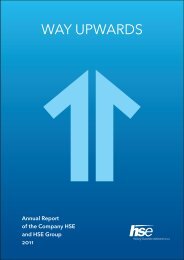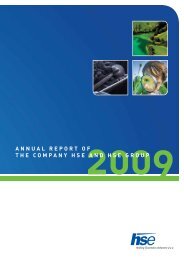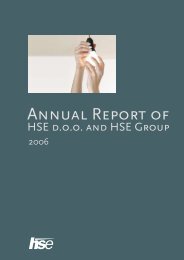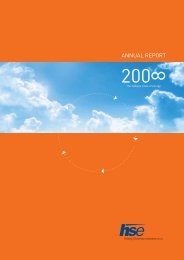Annual report - HSE
Annual report - HSE
Annual report - HSE
Create successful ePaper yourself
Turn your PDF publications into a flip-book with our unique Google optimized e-Paper software.
5.5.7.14 Revenue<br />
The sales revenue is recognised at fair value of the received payment of receivables,<br />
namely decreased by discounts. The revenue is disclosed when the buyer assumes all<br />
significant types of risks and benefits related to the ownership of the asset, when there is a<br />
certainty in relation to recoverability of a fee and related costs or possibility of repayment<br />
of products and when the Group stops deciding on products sold.<br />
Sales of goods are recognised when the Group delivers the products to the client. The<br />
client accepts the products, while the collectability of associated receivables is reasonably<br />
ensured.<br />
Sales of services is recognised in the accounting period in which the services are performed<br />
as regards the conclusion of the transaction estimated on the basis of actually performed<br />
service as the proportional portion of all services performed.<br />
Revenue arising from default interests charges and related receivables are recognised<br />
upon occurrence if it is probable that the economic benefits related to transaction will<br />
inflow to companies. On the contrary, default interest charges are recorded as contingent<br />
assets and are recognised in the Group’s books of account upon payments. Recording of<br />
default interest is considered individually.<br />
Other operating revenue related to operating effects are composed of revenue from the<br />
reversal of provisions, revenue from utilisation of deferred revenue, gains arising from<br />
sales of fixed assets, reversal of impairment of receivables, received compensations and<br />
contractual penalties, and similar revenue (ex. government assistance).<br />
Government assistance is considered as deferred revenue that a company strictly,<br />
consistently and wisely recognises as other operating revenue over the useful life of the<br />
relevant asset (on the other hand, the company discloses the amortisation/depreciation<br />
cost of this asset among operating expenses).<br />
Financial revenue comprises revenue from shares in investments, interest on loans<br />
and deposits given and revenue of associates. Interest revenue is recognised upon its<br />
occurrence, in the amount of agreed-upon interest rate.<br />
5.5.7.15 Expenses<br />
Expenses are recognised if a decrease in economic benefits in the accounting period gives<br />
rise to a decrease in assets or increase in debt and this decrease can be reliably measured.<br />
Operating expenses are recognised once costs are no longer held in inventories of products<br />
and work in progress or once merchandise has been sold. Costs that cannot be held in<br />
inventories of products and production in progress are recognised as operating expenses<br />
upon their occurrence.<br />
Costs of goods sold includes expenses related to the sales of electricity and contingent<br />
costs of electricity. In case the Group has more negative than positive operating foreign<br />
exchange differences, they are recorded as costs of goods sold.<br />
Costs of materials are historical costs of materials purchased that are directly used for<br />
creating products and services (direct costs of material), as well as costs of material that do<br />
not have such characteristics and are included in relevant purpose (functional) groups of<br />
indirect operating costs. The first subgroup includes costs of raw materials, other materials<br />
and purchased parts and semi-finished products whose consumption can be related to<br />
creating products and services. The second group includes costs of auxiliary materials<br />
for maintenance of property, plant and equipment, small tools whose useful life does<br />
not exceed one year, spare parts for servicing of products after their sale, office supplies,<br />
specialised literature and other items. Costs of materials cover also the accrued costs of<br />
shrinkage, spilling, breakage and failure.<br />
Costs of services are historical costs of purchased services that are directly used for<br />
creating products and services (costs of direct services) as well as costs of services that<br />
do not have such characteristics and are included in adequate purpose (functional)<br />
groups of indirect operating costs. The first group mostly includes the costs of services<br />
for production of goods, while the second group includes mainly the costs of transport<br />
services, maintenance services, services of fairs, marketing and entertainment, costs of<br />
insurance premiums, payment transactions and other banking services (except interest),<br />
rents, advisory services, business travels and similar services.<br />
<strong>Annual</strong> Report <strong>HSE</strong> 2012<br />
5 Financial Report of <strong>HSE</strong> Group<br />
181
















